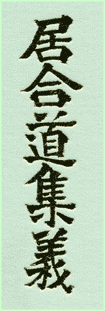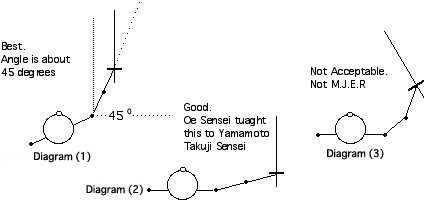|
SECTION 1 AN EXPLANATION OF IAIDO QUESTIONS AND ANSWERS: The questions in this section were drafted by the 20th Master Kono Hyakuren in 1928. The answers were written by the 18th Master Hokiyama Namio. In studying the way of Oh-e Sensei, there are many technical points to consider. Any additional explanations are submitted by myself (Iwata Norikazu). Question 1. Height of the right fist when making the Nukitsuke movement in the Seiza section? Answer. The height of the right fist is the same level as both the left and right shoulders. Addition : Keeping ones power/strength in the abdomen and waist during action. The fist cannot be over elevated. Oh-e Sensei told us, Aim for the neck. Question 2. Position of the right fist after completion of the Nukitsuke movement? Answer. The right fist should stop forward right of the right shoulder. If the right arm is opened out too much, the action becomes Hiki-giri (a pulling cut) rather than Nukitsuke. |
 |
Addition : a) The ideal fist position is about 20 cms from the horizontal shoulder line, the arm to be kept about 30 degrees to the front, Diagram (1). When my teacher Yamamoto Takuji was still a beginner Oh-e Sensei had told him to practice as in Diagram (2). He thought this was rather unusual and asked why.
 |
Oh-e Sensei replied, Because your body posture is not correct yet. So, do it this way until the time is right. Oh-e Sensei had a strong character, however, he was quite flexible in teaching individual students. Addition: b) The fundamentals of pushing the spirit, body and sword forward involve: |
1, Pushing the abdomen and waist a little forward at the same time.
2, Also push the right hand thumb a little forward at the same time.
If we keep the above two points in mind during practice, it is possible to make the transition from Diagram (2) to Diagram (1).
Question 3. Is the Kissaki position the same level as the fist?
Answer, Yes, this is quite correct. However, it is acceptable if the Kissaki is slightly lower than that of the fist.
Addition : In Nukitsuke,, the grip height was kept level with the right shoulder and the back of the hand was kept horizontal. The Kissaki should automatically be slightly lower than the fist. Obviously a great deal of practice with important detail is essential.
Question 4. The angle of the sword arm?
Answer. As stated in Answer 2. I do not think is necessary to re-explain at this point. Look at Diagrams (1) and (2) and compare the difference between them.
Addition : As in Question 2.
Question 5. The position of the right fist in Seiza-Noto.
Answer. Is the case of teaching ;
1) Beginners -- After finishing Chiburui, push the fist slightly forward to the right when bringing the Mune back to the Koikuchi (edge upward). At a beginners level this action will seem to be a little unnatural, but it will improve in time.
2) Advanced students -- Without pushing the fist forward, take Noto action using Sayabiki technique (Seiza, Tatehiza, Oku Iai are all the same).
Addition : The fist movement after Chiburui is very important. It is difficult to give a literary explanation. However the 18th Master Hokiyama Namio described this action as being done like Rubbing the bottom of a saucepan with the Kissaki.
My interpretation regarding this explanation is ;
a) Do Noto in one without stopping.
b) Whilst turning the blade edge to point upward, keep pushing the Kissaki forward very slightly with the intention of attacking the opponent.
c) Bring the Mune onto the Koikuchi in a continuous smooth movement.
Question 6. Forward movement of Nukitsuke footwork?
 |
Answer. When placing the right foot forward, the inside angle of the knee should be a little less than 90 degrees. The upper body must be kept vertical with a feeling of pushing forward. As a result of this, the body may appear to be slightly bent forward. |
Addition : The important points of foot movement and position are shown below in diagram (B). My teacher taught me to aim for diagram (A), because using this method, it is easier to adopt a correct posture and spirit. Please try to reason out both and decide for yourself.
Question 7. How about Chiburui in the Tatehiza section?
Answer Chiburui is towards the right-front of the body. Also The Kissaki finishes lower than the fist.
Addition : In traditional Eishin Ryu (Tatehiza), the right fist and the Kissaki are on the same straight line. With exception to shaking real blood of a sword, the Kissaki would practically end up a little outside the fist line. Hokiyama Sensei approved of this concept. Another actuality is that, when Nakayama Hakudo Sensei taught Omori- Ryu at the Toyama Army School in 1922 , he said that in Yaegaki (In-yo- Shintai in Shinden Ryu), Chiburui should be done as the arm, wrist and sword are brought to the right side of the body, Edge of the blade pointing right-hand downward. Nakayama Hakudo is respected as great Master and creator.
| Next page |